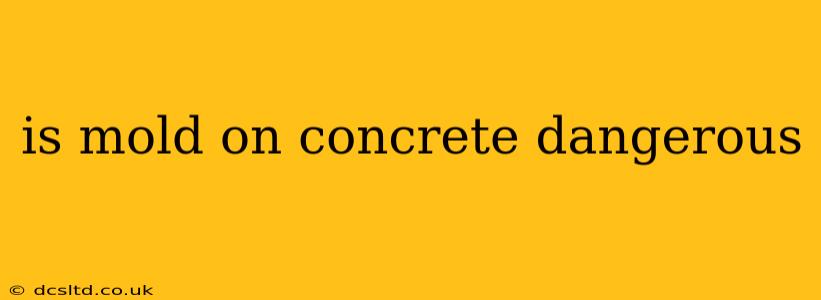Mold growth on concrete, while unsightly, can pose significant health risks if left unaddressed. This comprehensive guide explores the dangers of mold on concrete, its causes, prevention, and effective remediation strategies. We'll delve into the specifics to answer your pressing questions and help you protect your health and property.
What are the Dangers of Mold on Concrete?
Mold on concrete isn't just an aesthetic problem; it can trigger various health issues, especially for individuals with allergies or respiratory problems. Exposure to mold spores can lead to:
- Allergies: Mold spores are a common allergen, causing symptoms like sneezing, runny nose, itchy eyes, and skin rashes.
- Asthma Exacerbation: For asthma sufferers, mold exposure can trigger asthma attacks, leading to shortness of breath and wheezing.
- Respiratory Infections: Inhaling mold spores can contribute to respiratory infections like bronchitis and pneumonia, particularly in individuals with weakened immune systems.
- Other Health Problems: In severe cases, prolonged exposure to certain types of mold can lead to more serious health problems. However, it's important to note that the severity depends greatly on the type of mold, the level of exposure, and the individual's health.
What Causes Mold Growth on Concrete?
Mold thrives in damp, dark, and poorly ventilated environments. Concrete, being a porous material, readily absorbs moisture, providing an ideal breeding ground for mold if the moisture isn't properly managed. Several factors contribute to mold growth on concrete:
- Water Leaks: Leaky pipes, cracks in the foundation, or excessive humidity are major culprits.
- Poor Ventilation: Insufficient airflow allows moisture to accumulate, creating a humid environment conducive to mold growth.
- High Humidity: High humidity levels, especially in basements or crawl spaces, create a favorable environment for mold proliferation.
- Lack of Sunlight: Direct sunlight helps inhibit mold growth; areas lacking sunlight are more susceptible.
How Can I Prevent Mold Growth on Concrete?
Prevention is crucial in combating mold. Here are some key strategies:
- Address Water Leaks Promptly: Repair any leaks immediately to prevent moisture buildup.
- Improve Ventilation: Ensure adequate ventilation in areas prone to moisture, such as basements and bathrooms. Consider installing exhaust fans or dehumidifiers.
- Reduce Humidity Levels: Use dehumidifiers to control humidity levels, especially during humid seasons.
- Regular Cleaning: Regularly clean concrete surfaces to remove dirt and debris that can trap moisture.
- Use a Moisture Barrier: Applying a sealant or waterproof coating to concrete surfaces can help prevent moisture penetration.
Is Mold on Concrete Always Dangerous?
Not all mold is inherently dangerous. The level of risk depends on several factors:
- Type of Mold: Some mold species are more allergenic or toxic than others. Identification of the specific mold type is crucial for determining the appropriate remediation strategy.
- Amount of Mold: Small amounts of mold may not pose a significant health risk, especially if you're healthy and the mold is contained. However, large infestations definitely warrant professional intervention.
- Individual Sensitivity: People with compromised immune systems or pre-existing respiratory conditions are more susceptible to mold-related health problems.
How Do I Remove Mold from Concrete?
Removing mold from concrete is not always a DIY task, especially for extensive infestations. Small, localized areas can sometimes be cleaned using a solution of water and bleach (always following safety precautions), but larger infestations often require professional help. Professionals have the expertise and equipment to properly remediate mold and prevent its recurrence.
What Should I Do If I Find Mold on My Concrete?
If you discover mold on your concrete, assess the extent of the infestation. Small areas can sometimes be cleaned with a diluted bleach solution, but large infestations require professional mold remediation services. Remember to prioritize your safety and always wear appropriate protective gear when dealing with mold.
Is there a specific type of mold that is more common on concrete?
While various mold species can grow on concrete, certain types thrive in damp environments. Stachybotrys chartarum, often called "black mold," is known to grow in water-damaged buildings and is associated with more severe health effects. However, many other types of mold can also colonize concrete. Accurate identification usually requires professional testing.
This guide provides a general overview. Always consult with a qualified mold remediation professional for assessment and treatment of mold growth in your home. Their expertise ensures proper identification, safe removal, and prevention of future problems. Ignoring mold can lead to significant health problems and property damage. Proactive prevention and timely intervention are key to protecting your health and your home.
